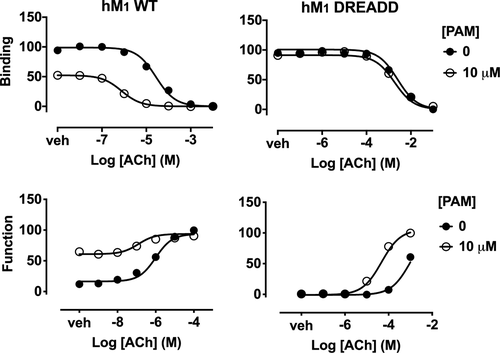当前位置:
X-MOL 学术
›
ACS Chem. Neurosci.
›
论文详情
Our official English website, www.x-mol.net, welcomes your
feedback! (Note: you will need to create a separate account there.)
Restoring Agonist Function at a Chemogenetically Modified M1 Muscarinic Acetylcholine Receptor
ACS Chemical Neuroscience ( IF 4.1 ) Pub Date : 2020-11-16 , DOI: 10.1021/acschemneuro.0c00540 Elham Khajehali 1 , Sophie Bradley 2 , Emma T van der Westhuizen 1 , Colin Molloy 2 , Celine Valant 1 , Lisa Finlayson 2 , Craig W Lindsley 3 , Patrick M Sexton 1 , Andrew B Tobin 2 , Arthur Christopoulos 1
ACS Chemical Neuroscience ( IF 4.1 ) Pub Date : 2020-11-16 , DOI: 10.1021/acschemneuro.0c00540 Elham Khajehali 1 , Sophie Bradley 2 , Emma T van der Westhuizen 1 , Colin Molloy 2 , Celine Valant 1 , Lisa Finlayson 2 , Craig W Lindsley 3 , Patrick M Sexton 1 , Andrew B Tobin 2 , Arthur Christopoulos 1
Affiliation

|
Designer receptors exclusively activated by designer drugs (DREADDs) have been successfully employed to activate signaling pathways associated with specific muscarinic acetylcholine receptor (mAChR) subtypes. The M1 DREADD mAChR displays minimal responsiveness to the endogenous agonist acetylcholine (ACh) but responds to clozapine-N-oxide (CNO), an otherwise pharmacologically inert ligand. We have previously shown that benzyl quinolone carboxylic acid (BQCA), an M1 mAChR positive allosteric modulator (PAM), can rescue ACh responsiveness at these receptors. However, whether this effect is chemotype specific or applies to next-generation M1 PAMs with distinct scaffolds is unknown. Here, we reveal that new M1 PAMs restore ACh function at the M1 DREADD while modulating ACh binding at the M1 wild-type mAChR. Importantly, we demonstrate that the modulation of ACh function by M1 PAMs is translated in vivo using transgenic M1 DREADD mice. Our data provide important insights into mechanisms that define allosteric ligand modulation of agonist affinity vs efficacy and how these effects play out in the regulation of in vivo responses.
中文翻译:

恢复化学遗传学修饰的 M1 毒蕈碱乙酰胆碱受体的激动剂功能
仅由设计药物激活的设计受体 (DREADD) 已成功用于激活与特定毒蕈碱乙酰胆碱受体 (mAChR) 亚型相关的信号通路。 M 1 DREADD mAChR 对内源性激动剂乙酰胆碱 (ACh) 的反应性极小,但对氯氮平-N-氧化物 (CNO)(一种药理学惰性配体)有反应。我们之前已经证明,苄基喹诺酮羧酸 (BQCA),一种 M 1 mAChR 正变构调节剂 (PAM),可以挽救这些受体的 ACh 反应性。然而,这种效应是否是化学型特异性的或是否适用于具有不同支架的下一代 M 1 PAM 尚不清楚。在这里,我们揭示了新的 M 1 PAM 恢复了 M 1 DREADD 处的 ACh 功能,同时调节 M 1野生型 mAChR 处的 ACh 结合。重要的是,我们证明 M 1 PAM 对 ACh 功能的调节是使用转基因 M 1 DREADD 小鼠在体内翻译的。我们的数据为定义激动剂亲和力与功效的变构配体调节机制以及这些效应如何在体内反应的调节中发挥作用提供了重要的见解。
更新日期:2020-12-16
中文翻译:

恢复化学遗传学修饰的 M1 毒蕈碱乙酰胆碱受体的激动剂功能
仅由设计药物激活的设计受体 (DREADD) 已成功用于激活与特定毒蕈碱乙酰胆碱受体 (mAChR) 亚型相关的信号通路。 M 1 DREADD mAChR 对内源性激动剂乙酰胆碱 (ACh) 的反应性极小,但对氯氮平-N-氧化物 (CNO)(一种药理学惰性配体)有反应。我们之前已经证明,苄基喹诺酮羧酸 (BQCA),一种 M 1 mAChR 正变构调节剂 (PAM),可以挽救这些受体的 ACh 反应性。然而,这种效应是否是化学型特异性的或是否适用于具有不同支架的下一代 M 1 PAM 尚不清楚。在这里,我们揭示了新的 M 1 PAM 恢复了 M 1 DREADD 处的 ACh 功能,同时调节 M 1野生型 mAChR 处的 ACh 结合。重要的是,我们证明 M 1 PAM 对 ACh 功能的调节是使用转基因 M 1 DREADD 小鼠在体内翻译的。我们的数据为定义激动剂亲和力与功效的变构配体调节机制以及这些效应如何在体内反应的调节中发挥作用提供了重要的见解。


















































 京公网安备 11010802027423号
京公网安备 11010802027423号